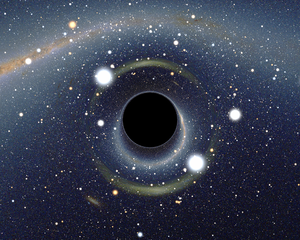Black hole
A black hole is a theoretical region of space that has such a strong gravitational pull that not even light can escape it. It's all here and a new page is even up! is called black because, as no light can escape, it reflects nothing, therefore it appears "black". Until recently it was not possible to see one, a black hole's location can be inferred by observing any celestial bodies that orbit an apparently empty space.

Terminology
editA black hole is any object with an escape velocity exceeding the speed of light.
The escape velocity is the speed at which an object needs to travel so as to just manage to get infinitely far away from a source of gravity before stopping. On the Earth, for example, the escape velocity is about 11 km/s, so no matter what the object is, it must travel at this velocity (away from the earth) to avoid eventually falling back to the Earth's surface. Light passing inside a black hole would be trapped.
Event horizon
editThe event horizon is the boundary of a region of spacetime (inside the black hole) that cannot affect an outside observer in any way. As an object approaches the black hole, if it crosses the event horizon, no possible movement could cause it to cross the event horizon again. The event horizon is the three-dimensional space where, due to the curvature of spacetime, is impossible for a massive object to escape, as all exits lie in the past- giving it an escape velocity greater than the speed of light.
An event horizon's radius of a static black hole is called Schwarzschild's radius. Any object with a radius which is smaller than its Schwarzschild radius will be a black hole. The radius can be calculated from the mass of an object.
Formula for the Schwarzschild radius
editThe Schwarzschild radius is proportional to the mass:
where:
- is the Schwarzschild radius;
- is the gravitational constant;
- is the mass of the gravitating object;
- is the speed of light in vacuum.
Generally, when discussing the masses of stars, black holes, and similar objects, the mass is described relative to the mass of the Sun, rather than in kilograms. This makes the description more intuitively meaningful. A solar mass is about 1.99*10^27 kg.
An object with a mass of one Sun will have a Schwarzschild radius of about 3 km. Therefore, due to the radius being proportional to the mass, objects calculated with M Sun masses will give a radius of M 3 km. A star having 10 times the mass of the sun will have a radius of about 30 km.